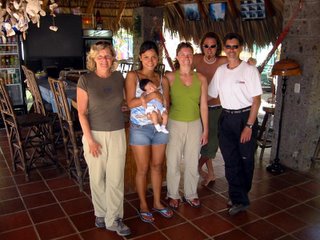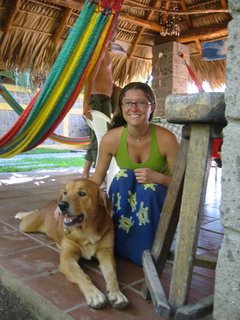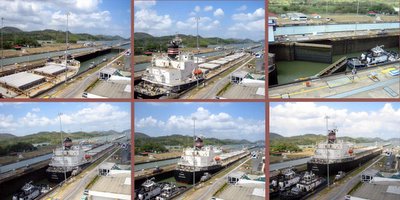
At Dinner in Alegria, El Salvador (you can't see the view in this shot but is incredible)

Dave catching a wave while in El Zonte

The coffee area arounf Alegria. The coffee plantations go right to the top of these hills.

A View of Alegria from our hike to the lake.
February 7/06
Reluctantly we are leaving El Zonte this morning. We are just finishing breakfast and settling the tab. A great place and very good value. I should be keeping this place a secret!
We are heading back into the mountains again today. To a small village called Alegria (“alegria” is “joy” in Spanish). It is located about ½ way from El Zonte to the Honduras border. It is only about 150 K from here so we should have time to check out a small lake nearby that has been recommended.
There was a choice of two routes to Alegria. The shorter route was shown on the map as a secondary highway. This is the route we decided to take. Even though it started as a gravel road it appeared to be in good shape. That is until we started climbing into the mountains. The road quickly adopted characteristics very similar to those of logging roads in BC . . . tight turns, steep grades, rutted and very dusty. We passed through two small villages on the way up to Alegria. Their rough coble stones streets were a temporary relief from the loose dusty soil of the “secondary highway”. By the time we reached our destination we and the bikes were covered in dust.
Alegria is located on high ridge in the middle of the coffee growing area. The views are spectacular. You can see most of the El Salvador and into Guatemala and Honduras from this location. It is a pretty little town. Not at all touristy. Unfortunately for us, the town square (park) is currently under renovation and is fenced off. We peeked through the fence. It looks like it will be a very attractive town centre piece when it is reopened.
We stopped at an internet café for drink and asked about accommodation. There are no “hotels” in town but several guest houses. One of these was affiliated with the coffee shop and located next door. We inquired about the location of the nearby lake and it was suggested that we hire a guide to take us up to the lake and show us around. Before we could answer, a call was made and a young fellow (18 years old) arrived at the shop. He wanted $5. to guide us for the afternoon. After discussing our options we decided to get a room and go for a hike.
After storing the bikes in the guest house garage and getting changed we head out for “Laguna de Alegria”, a small lake in a extinct volcano crater. It is pleasant hike up coble stone roadways for about 2.5K to the lake. We walked around the lake and returned on dirt paths to town. As I mentioned the area is one of the main coffer growing areas in El Salvador. Coffee grows on steep slopes. The plants are large bushes that grow to a height of approx 3 meters. There are other taller trees growing along with the coffee plants. No machine picking here!
Our guide was a nice young fellow. He is currently attending a school to learn English and French although we communicated primarily in Spanish. Often many words in Spanish are similar to either French or English words and we could often get the drift of the explanation, even though we did not understand every word. On the way back to town he showed us a very nice restaurant with spectacular views. Since it was time to eat we invited him to join us. Once again, a very good meal and of course the obligatory beverage… cervezas.
We are now located about 2 hours from the Honduras border. We are planning and early start and we are expecting a lengthy border crossing. Where we stay tomorrow night depends on how long it takes to deal with the paperwork.
February 8/06
Happy Birthday Lee! Great talking to you the other evening.
Well, the Honduras border seemed like it was going well until the last step. We had managed to exit El Salvador with no problems or assistance (despite aggressive advances from numerous “helpers”). Customs into Honduras was no problem either. The officials were very helpful and once again assisted us with the documentation. When it came to getting the permits for the bike… that’s a different story.
We are not sure yet, whether we were conned or not, but the process we followed would be virtually impossible without guidance. We had to visit 6 offices in sequence. These offices had no names or signs! After leaving the 1st office in the sequence we hired a fellow (for $5.) to assist us. $10. with a receipt got us past the second office. (It was quite funny… when Dave gave the gal his documentation; she walked back to the card game in progress, tucked the papers under her leg and dealt the next hand.) When the hand was over we received the appropriate stamps and were on our way to the bank to pay for the permit. (approx $30. each). Then to office #3. In office 3 we were told that we needed multiple copies… 8 in total of various documents. We were also advised, by our helper, that this fellow could expedite the process for $5. each. We agreed and left for the photocopy office. We needed copies of various pages of our passport, registration, drivers licence and forms we had previously received. Now back to the previous office to complete the paper work. After sorting the papers, stapling them together and collecting 10 bucks from us, we were on our way.
Like I said at the earlier…. We have no idea if all or any of this was legitimate, but it was done and we headed down the road into Honduras.
The part of Honduras we passed through today is obviously not well off. The topography consisted of semi-arid rolling hills, practically void of agriculture. We figured that we could not get through the Honduras / Nicaragua border and then find accommodation before dark so we found a place in Choluteca, Honduras. The hotel (Santa Rosa) is OK but we are finding that the prices are high. (see note.)
***** Note: Jen, Linda and Dave just came back from the market with some food for supper. They think that we were definitely scammed on one of the money changes at the border! We think that we received 8.75 Lempiras for the US dollar. The exchange rate is 19 to the dollar! Luckily we only changed $50. US. Later I changed more money and received the proper exchange rate. We knew the rule (Know the exchange rate.) but in the confusion, we ignored it… to our dismay… next time we will be more careful. (Jamie & Karla: I don’t think my “tengo camisa negra” T-shirt help with the border crossing but I received quite a few smiles and waves from young girls…)
When we lived in Winnipeg and drove out to Fernie, we joked that if we could eliminate Saskatchewan, it would be a nicer, shorter drive. Well. Honduras is somewhat like that. You cannot avoid passing through it, if you want to go father, but it would be nice if you could. Anyway, that’s our experience.
(After re-reading this last paragraph it might seem that I am comparing Saskatchewan to Honduras. Not at all. There is NO comparison. I’m just saying that you cannot avoid Honduras if you take this route. Hopefully, Karla’s family is still speaking to us.)
We have another border crossing tomorrow. (Honduras to Nicaragua) We have heard that it is expensive one too, but we are better prepared this time. Hopefully we can put in a long day and reach south-western Nicaragua (the San Juan Del Sur area) by tomorrow evening. We plan to hole-up there for a few days doing day trips around the area.
February 9/06
We arrived in San Juan Del Sur, Nicaragua just before sunset. We had hoped to arrive a little earlier but we had a couple of run-ins with Nicaraguan officials enroute.
The border crossing went quite smoothly. We reached the border early and as we rolled up to the border area we were once again approached by money changers and potential helpers. This time we were prepared and took things in stride. We knew the exchange rate and even though the first offer was low we quickly got the rate we wanted from another changer.
It is hard not to use a helper unless you are familiar with the crossing in question. They are all different and not at all like the US/Canada border crossing to which we are accustomed. Sometimes it is hard to tell when you actually reach the border.
The helpers are pretty smooth. They simply point out where you need to start and then follow you from there. Soon you realize that you could probably do it yourself without assistance, but everything goes smoother when you have a guide. You save time and eliminate the misunderstandings that are bound to occur when there is a language barrier. Anyway all of us managed to get processed in short order. After tipping the helper $5, we were off to the Nicaragua vehicle customs. It is a couple of kilometres across the bridge separating Honduras and Nicaragua. When we reached this facility Dave and I located the correct office and the paperwork was processed.
There is usually one more checkpoint as you leave the customs area. You have to show the proper documentation to continue on. However, at this point we told we needed to buy Nicaraguan insurance. It is mandatory and it costs 210 Cordobas (about $15.). It was interesting that we were stopped at the insurance roadside stand by a uniform police officer and another fellow plus the insurance agent. Once we paid for the insurance we were told that we also had to pay each of these fellows 100 Cordoba each. We told them no problem but we needed a receipt. After a bit of mumbling and grumbling they waved us on. That was the first encounter with police today.
Our trip through Nicaragua was interesting because it was all new to us but the country side was dry and uninteresting. The only interesting feature in north western Nicaragua was the volcano that we circumnavigated. It is the dominate geographic feature in the flat dusty plains. Sugar cane is the major crop in this area. Also the road was in bad shape. The road on our map was shown as a main road (CA6) but the first 20K was a mine field of pot holes in the paved areas. The paved areas were punctuated with stretches of course gravel. Later we ran into similar conditions on another secondary highway. Nicaraguan highways certainly are the worst we have encountered so far. Even the main highways were substandard by comparison.
Nearing our destination we had another encounter with the authorities or I should say I did. There are many buses on the road here from Greyhound style to minivans. In this particular situation I was following a minivan bus on a 2 lane major highway. The minivan slowed and pulled onto the shoulder to pick up passengers. I slowed and since there was no opposite direction traffic coming toward me I gave the minivan a wide berth by moving left into the opposing lane. As I came round the mini van there were 2 cops 100 metres ahead they signalled me (us ) to stop. We stopped.
We had been warned not to give our drivers licence to a cop. Of course the first thing I was asked for was registration and licence. I showed them my licence but refused to give it to them. I produced a copy of my licence and handed it to them. They were not satisfied with this manoeuvre. Eventually I gave them my licence. I was charged with 2 offences. One was that I crossed the solid line on the highway in contravention of the highway act. The other I never did figure out.
They wrote me out a ticket then explained that my licence was to be sealed in an envelope and mailed to Managua. I would have to go to Managua and pay the fine to retrieve my licence. To make a long story short I eventually asked if I could pay the fine here and now. $20 bucks for each cop and we were on our way. (so this is $40. story).
Anyway… we have discovered since that this type of thing is a common occurrence in Nicaragua. We met 2 young guys from Saskatchewan who had received 4 tickets in 2 days… on of them was for driving a car in sandals!
The episode was no big deal but it makes Nicaragua less attractive as a tourist destination. We are planning to stay in San Juan Del Sur area for a few days of rest. Hopefully we get a better impression of Nicaragua tomorrow.





 Another one of the guests in El Zonte
Another one of the guests in El Zonte



























